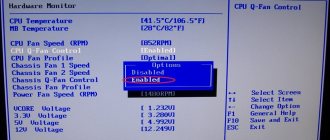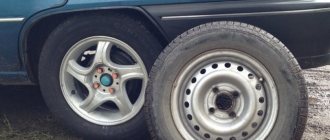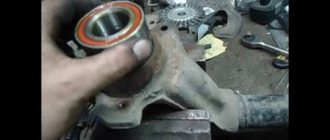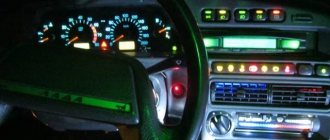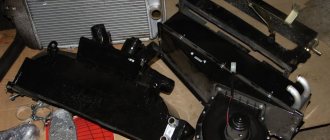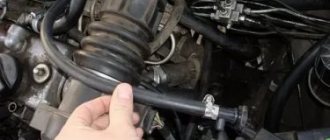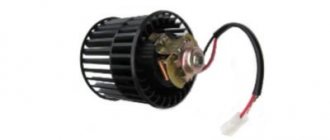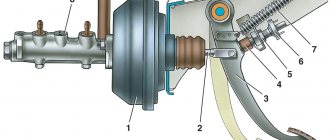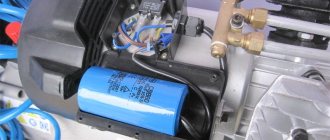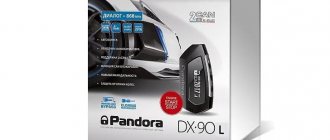We independently repair the heater on a Daewoo Nexia car
If the heater in a passenger car fails in severe frost, this will not end well for the driver, especially if he managed to travel far from home. This applies to all cars, and the Daewoo Nexia is no exception. Is it possible to avoid breakdown? Are there typical malfunctions of stoves on Nexia and how to fix them yourself?
The operating principle of the Daewoo Nexia heating system
The heating system in a car is designed as follows. The engine of the machine becomes hot during operation. To cool it, antifreeze is used, poured into the engine cooling jacket. This liquid heats up along with the engine, and when heated, it goes into the main radiator of the car. From there, through a system of pipes, hot antifreeze enters a small radiator of the stove, blown by a small fan. Heat from there enters the cabin through special air ducts and heats it. In the rear doors of the car there are exhaust openings necessary for ventilation of the interior. Excess heat escapes through them.
Diagram of the main elements of the heating system on the Daewoo Nexia
Here it should be noted one feature of the Daewoo Nexia heating system: it can operate independently of the air conditioner. Such design solutions on passenger cars are quite rare. The heater of the Daewoo Nexia not only heats the interior, but also prevents the glass from freezing, and it can work together with the air conditioner. This feature is useful if the driver wants to reduce the air temperature in the cabin by several degrees without turning off the heater.
Heater motor
The heater electric motor is installed behind the stove radiator. This compact motor rotates a plastic impeller, creating a continuous flow of air through the radiator tubes. The motor housing is metal, inside there is a rotor with copper winding and a central shaft on ball bearings.
The heater motor housing on the Nexia is made of tool steel
Metal-graphite brushes fit tightly to the rotor, removing the electrical charge. The engine catalog number is 6841SB566905. It is compatible with other Daewoo vehicles (for example, Daewoo Espero). Cost - from 5000 rubles.
Heater Vacuum Switch
The vacuum switch for the heater on the Daewoo Nexia is located behind the glove compartment. It is this device that is responsible for opening and closing the external air intake damper and the warm air recirculation dampers in the cabin.
The dampers on the Daewoo Nexia are opened using a vacuum switch
It is controlled using buttons located on the heater control unit. The device catalog number is ER200347893. The cost of a vacuum switch in Daewoo brand stores is from 600 rubles.
Heater fuse location
The Daewoo Nexia safety block is located under the dashboard, above the gas and clutch pedals.
: Selecting materials and painting a leather steering wheel with your own hands The Nexia's stove fuse is located in the lower right corner of the block: it is green
It is closed with a plastic cover, on which there is a sticker with a diagram of the location of all fuses and relays.
The Nexia safety block is located above the pedals and is covered with a plastic cover
The fuse responsible for the heater is located in the lower right corner of the block and is designated as F19.
The fuse responsible for the Daewoo Nexia stove is marked F19
The same block contains a furnace fan relay, used in situations where the heater motor is running at low speeds.
Main malfunctions of the Daewoo Nexia heating system
There are many reasons why the stove may stop heating the interior of the car. Let's list the most common ones.
Oven radiator clogged
The heater radiator, like any other part, becomes unusable over time. This usually happens due to the use of low-quality antifreeze with an abundance of impurities. They form a layer of scale on the radiator tubes and its throughput begins to decrease. Eventually, fluid stops flowing into the radiator and the cabin becomes cold, despite the fact that the heater fan is operating normally. The problem is resolved by replacing the radiator.
The operating principle of the Daewoo Nexia heating system
The heating system in a car is designed as follows. The engine of the machine becomes hot during operation. To cool it, antifreeze is used, poured into the engine cooling jacket. This liquid heats up along with the engine, and when heated, it goes into the main radiator of the car. From there, through a system of pipes, hot antifreeze enters a small radiator of the stove, blown by a small fan. Heat from there enters the cabin through special air ducts and heats it. In the rear doors of the car there are exhaust openings necessary for ventilation of the interior. Excess heat escapes through them.
Diagram and design of the Daewoo Nexia heater
The design of the Daewoo Nexia stove must be considered in the overall climate system of the vehicle, which also includes air conditioning and ventilation. The heater is used to create a comfortable temperature in the vehicle interior, regardless of weather conditions. Moreover, the temperature inside the car directly depends on how warm the engine is. Further details about the principles and features of the system under consideration.
Operating principles of the stove
Interior ventilation begins with the air intake, which is located under the windshield, inside the protective box. This design provides a constant flow of fresh air, regardless of the operation of the heater. The driver can turn on the heater, which will enhance the effect of ventilation or warming the car interior. To learn more about how the second option works, consider the Nexia climate system diagram.
The device of the Daewoo Nexia stove
The diagram of the Daewoo Nexia stove, which heats the interior, consists of the following elements:
- Heater radiator. The main element of the car interior heating system. The device changes the temperature of the air captured from the street, which warms up the car and blows across the windshield. The process occurs due to the interaction of heated antifreeze and the walls of the heater. Therefore, it is important that the coolant reaches 85-90 degrees.
- Fan. At high speeds, drivers prefer to turn off this element, since air enters the system on its own. If the car is stationary, then you have to use a supercharger, which consists of a motor and an impeller.
- Thermostat damper. An element that helps the driver control the amount of air directed directly through the heater core. If you reduce the gap, the cabin will become cooler and vice versa. Control is carried out from a common module.
- Executive element. The most important part in the heater module, which allows the vehicle owner to direct air flow in different directions. The principle of operation is to switch dampers that open or close the lines.
- Pipes, rods. With their help, the supply of heated coolant is ensured, which is necessary to create warm air in the climate system of the Daewoo Nexia.
If everything is clear with the elements of the heating system on the Daewoo Nexia, then all that remains is to understand the features of controlling this element of the car.
Features of controlling the Daewoo Nexia stove
The heating system on the car in question functions separately, without connection to the air conditioner. The stove warms and ventilates the interior, preventing fogging of the front and side windows.
Sometimes drivers turn on the air conditioning while the heater is on. This allows you to quickly refresh the air inside the car and continue to warm the windows from fogging. A special feature of the climate system control on Daewoo Nexia is the fact that cooling and heating are located in one module. Therefore, the driver just needs to use the regulators located on the instrument panel to control the temperature inside the car.
The Daewoo Nexia stove is controlled using the following elements that can be found on the instrument panel:
- fan speed switch. The adjustment occurs in the direction of decreasing or increasing this indicator. Moreover, the setting is not flexible and is limited to four positions;
- turning on the air flow recirculation mode;
- temperature adjustment by turning the damper;
- turning on the air conditioning system;
- air flow direction regulator inside the cabin, for example “Legs-Face”.
At the same time, the modes of the Daewoo Nexia stove are not affected by the position of the incoming air temperature regulator. The four fan speeds are changed using the difference in voltage supplied to the motor. In this case, the damper changes its position using a drive, and the thermostat is connected by a cable to the actuator.
Recycling
The heating system of Daewoo Nexia implies the presence of an air recirculation function. This is a mode that involves using air from the cabin rather than from the street. This is relevant in cases where the car is passing through an area of heavy smoke or gas pollution. It is important to close all windows, otherwise there will be no point in switching.
However, the driver and passengers may feel a headache if this mode is turned on for more than 15 minutes. This is due to the fact that oxygen does not enter the car, and the concentration of carbon dioxide exceeds the norm. Therefore, recirculation is used only in extreme cases, when there is, for example, heavy smoke outside and action has to be taken to prevent harmful chemical compounds from getting into the car. As soon as the car has passed the danger zone, the mode is turned off.
Removing the heater control unit on the Daewoo Nexia
The control of the heater and air conditioner on the car is arranged in one control module located on the dashboard, to the right of the driver. The buttons on this module fail quite rarely. However, the need to remove the control unit may arise if the vacuum switch, which was mentioned above, breaks down. There is nothing difficult in dismantling the block, and you only need a flat-head screwdriver to do the job.
Sequence of dismantling the control unit
To remove a broken device, it is wise to follow the recommendations of experienced repairmen:
- Two deflectors are manually removed from the central air duct located above the control unit, then the plastic frame of the air duct, held in place by two latches, is removed.
The frame and deflectors of the Nexia air duct have been removed, there is access to the wires of the control unit - By sticking your hand through the hole in the central air duct, you need to disconnect all the vacuum tubes and damper cables from the control unit.
After disconnecting the wires, the Nexia control unit can be pryed off with a screwdriver and removed from its original location - Now the control block is pryed off with a flat screwdriver and removed from its niche.
The catalog number is clearly visible on the top of the Daewoo Nexia climate control unit
Video: removing the climate control unit from the Nexia
The Daewoo Nexia stove does not work: reasons, repairs, video
With the onset of winter, motorists begin to use the heater. But in life it happens that the Daewoo Nexia stove stops supplying warm air to the cabin. There are a lot of reasons for the malfunction, but don’t be upset, everything can be fixed without even resorting to the participation of a car service.
The materials will tell you about repairing the heater, replacing the heater radiator, as well as diagnosing and repairing the unit.
Causes of interior heater malfunction
The heating system of Nexia has a standard design, like all Daewoos of this class. When diagnosing a stove, there are mechanical and electrical faults. So, the radiator may become covered and suddenly leak, or the pipe may become clogged. On the other hand, the problem may lie in an electrical fault. Let's look at the main nodes where we will look for the problem:
- Radiator.
- Heater control unit.
- Motor.
- Circuit breakers.
The main points and locations of the malfunction have been identified, and you can begin diagnosing and repairing.
Heater radiator
The first sign of a malfunctioning heater core is a leak from the element itself. If the heating system shows signs of leaking, it must be replaced, otherwise there will be no warm air in the cabin. It is worth understanding that replacing the stove radiator, according to factory technology, is carried out after removing the dashboard. But car enthusiasts have come up with a way in which they do not need to dismantle the tidy.
So, let's look at how to dismantle the stove radiator using minimal means:
- We drain the coolant from the system so that it does not flow into the cabin.
- From the engine compartment side, disconnect the outlet and inlet pipes.
- We remove the glove compartment.
- We rest against the heater radiator, which can only be removed from its seat.
If the procedure seems quite complicated, then you will have to dismantle the instrument panel and remove the radiator according to the factory diagram.
Radiator selection
The original catalog number of the heater radiator for the Daewoo Nexia is 03059812 . It is also worth indicating the dimensions:
- N100 - 182x141x51;
- N150 - 180x138.5x26.
The average cost is 5,000 rubles. In addition, there are a number of analogues that are not inferior in quality to the original.
| Manufacturer | Catalog number | Price |
| Thermotec | D60002TT | 1500 |
| Polcar | 2910N8-1 | 2000 |
| Asam | 50118 | 2500 |
| Stellox | 10-35104-SX | 2500 |
| Zekkert | MK-5030 | 2500 |
| Magneti marelli | 350218253003 | 2700 |
| Van Wezel | 81006026 | 2700 |
| Pmc | PXNHC-001 | 3500 |
| Luzar | LRh DWEs94312 | 4000 |
Cold air blows, does not heat. This reason is also hidden in the stove radiator. This may be due to the fact that there is a blockage in the pipes or the radiator itself. To eliminate the problem, you can try to clean it, but this may not help, and you will still have to replace the radiator itself or the pipe. For cleaning, you can use cooling system flushing products that are sold on the automotive market or in car dealerships.
Heater control unit
Another place that can cause a malfunction is the heater control unit. This is a mechanical-electrical part that serves as a control to regulate the interior temperature. There are two rods on it that regulate the opening and closing of the tap. In this case, the malfunction may lie in the heater cable.
The second type of malfunction is a malfunction of the electrical part of the unit. In this case, as practice shows, it is recommended to replace the unit completely, or give it to specialists for resoldering. Repair is good, but replacement is best.
Fuses, relays and electrical
If the motor “dies,” then most likely the malfunction is caused by a blown fuse. On the Daewoo Nexia, these elements are located both under the hood and in the cabin. Of course, you can find pinouts on the fuse box covers. Replacing the fuse element may help solve the problem.
Heater motor
Often the heater motor itself may fail. This may result from damage to the winding or combustion of the motor itself. In this case, the element may squeak or not start at all. To fix the problem, you will have to change the motor.
Main malfunctions of the Daewoo Nexia heating system
There are many reasons why the stove may stop heating the interior of the car. Let's list the most common ones.
Oven radiator clogged
The heater radiator, like any other part, becomes unusable over time. This usually happens due to the use of low-quality antifreeze with an abundance of impurities. They form a layer of scale on the radiator tubes and its throughput begins to decrease. Eventually, fluid stops flowing into the radiator and the cabin becomes cold, despite the fact that the heater fan is operating normally. The problem is resolved by replacing the radiator.
A thick layer of scale and dirt is clearly visible in the Nexia’s radiator grille
Air lock in the heating system
Typically, a breakdown occurs when the tightness of a pipe in the heating system is lost. When air gets there, the circulation of antifreeze is disrupted, and it simply does not reach the stove radiator. The solution is to completely drain the antifreeze and then blow out the heating system with compressed air.
Due to ruptures in the air duct pipes in the Nexia heating radiator, air jams may occur
Vacuum switch failure
The vacuum switch on the Nexia is a reliable device, but the mounting strips on which it is held are quite thin and often break. This can lead to the fact that the air intake damper simply stops opening and the normal circulation of warm air in the cabin is disrupted. To fix the problem, the driver will have to purchase a new vacuum switch, since mounting strips for it are not sold separately.
Destruction of electric motor bearings
As mentioned above, the central shaft of the heating electric motor with the impeller is suspended on two ball bearings, which can collapse over time. If this happens, then after turning on the stove the driver will hear a characteristic creak, gradually turning into a loud grinding sound. The problem can only be solved by replacing the furnace electric motor, since the bearings for it are not sold separately.
Bearings on Nexia electric furnace motors often fail
The stove does not blow on your feet
This type of failure occurs when the vacuum switch that controls the dampers fails. After this, the dampers are lowered to their lowest position. As a result, the access of hot air to the legs of the passenger and driver is almost completely blocked. The problem is solved by removing the glove compartment and replacing the vacuum switch.
Installation of an additional furnace pump on the Daewoo Nexia
Since the heating system on cars of the brand in question has never been very powerful, many owners make additional efforts to insulate their car. One way to increase the heater power is to install an additional pump. As a rule, they install a pump from a GAZelle.
As an additional pump, a GAZelle pump is installed on the Nexia
Sequence of installation of an additional pump
Device installation procedure: Main elements that must be taken into account when connecting an additional pump to the Nexia
- Now you need to open the hood and find the pipe going from the heater to the engine.
The hose is cut at the bend (but before doing this, it is advisable to clamp it with steel clamps before and after the cut, so that the antifreeze does not leak out). The ends of the cut pipe are put on an additional pump. The clamps holding the antifreeze are removed. The additional Nexia pump has been successfully connected to the antifreeze pipes, all that remains is to apply power - An additional pump connected to the pipes is attached to the air conditioner pipe using a plastic clamp.
To prevent the pump from rubbing the air conditioner tube, it is recommended to place a small piece of thick rubber under it. The pump is screwed with a plastic clamp to the pipe of the Nexia air conditioner. The pump relay is best installed on a contact block near the air duct - The positive contact, responsible for turning on this relay, is connected to a separate button in the passenger compartment (the power supply to which is most conveniently supplied from the ignition switch).
Video: installing an additional pump on the Nexia
The heater on the Daewoo Nexia car can hardly be called a perfect device. The stove can cause the driver a lot of problems, especially if it has been in use for a long time. Fortunately, most of them can be solved independently, without resorting to the expensive services of service specialists - a very popular model on the Russian market. The combination of consumer qualities attracts many car enthusiasts. A spacious interior, a spacious trunk, and inexpensive spare parts make it one of the leaders in the secondary market among budget cars. But, as always, there are shortcomings here too, in particular the design of the heating system. If the car is still more or less new, then there is no problem with this. But if it has already “exchanged” a hundred thousand kilometers, then in the cold Russian winters the insufficient efficiency of the heater causes discomfort. What to do when the stove in the Daewoo Nexia does not heat well? Repairs (see photos in our article), and more often modernization, can be carried out independently. Of course, provided that the power unit itself is in fully working order, and the coolant is filled in in the required quantity. So let's look at the problem.
